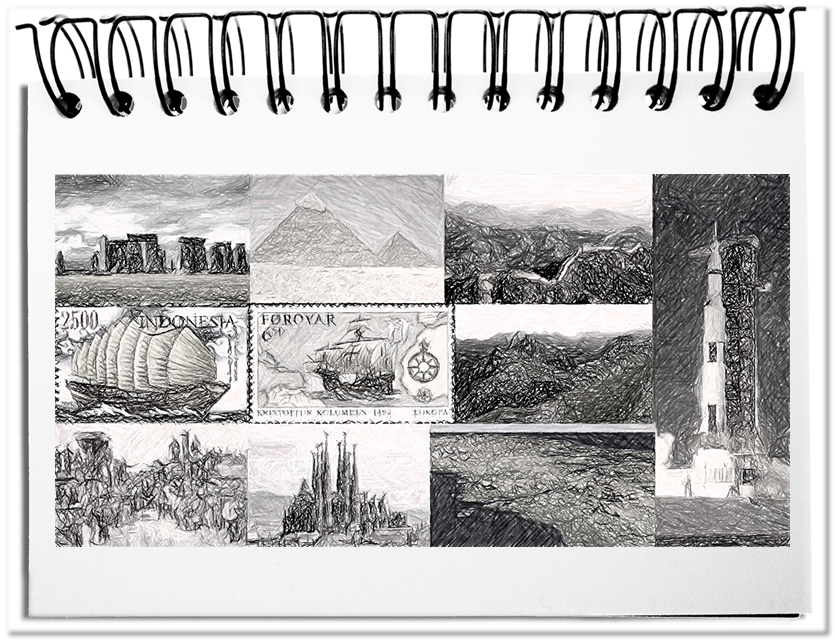Die Geschichte zeigt sich bis heute in diesen dauerhaften Monumenten, die alle kennen. Dazu gehören riesige Steinbauwerke, wie Stonehenge, die ägyptischen Pyramiden oder die Chinesische Mauer, aber auch die Entdeckungen der Welt durch Zheng He, Christoph Kolumbus bis hin zur Landung auf dem Mond. Alle diese Großprojekte erfolgten ohne das, was wir heute Projektmanagement nennen. Unsere heutigen Großprojekte scheitern immer öfter. Irgendwas machen wir wohl falsch.
Die Beteiligten dieser Aktivitäten haben bei der Durchführung nicht ihren Schwung verloren, bis die Monumente fertig waren – über Jahre, Jahrzehnte oder Jahrhunderte hinweg.
- Die Erschaffung der Welt
Das allererste Großprojekt überhaupt wurde innerhalb von sieben Tagen durchgeführt. Alles begann mit der Festlegung des zeitlichen Rahmens. Im zweiten Schritt wurde der räumliche Rahmen festgelegt. Nachdem die Funktionsbereiche am dritten Tage aufgebaut und grundsätzlich ausgestattet waren, wurden am vierten Tag die wichtigen Energiequellen installiert. Die Ressourcen wurden am fünften Tag aufgeteilt. Am sechsten Tag wurde das Management aufgebaut und der Projektleiter hat sein Projekt durchgesehen und für gut befunden. Im letzten Schritt hat sich der Projektleiter ausgeruht und sein Projekt abgeschlossen. - Stonehenge
Die „hängenden Steine“ in der Nähe von Amesbury, in Wiltshire, England, ist vielleicht eines der ältesten Projekte. Das Projekt wurde 8000 v.Chr. gestartet. Die drei Hauptphasen begannen 3100 v.Chr. mit einem kreisrunden Erdwall. Für die zweite Phase im frühen 3. Jahrtausend v. Chr. gibt es keine Belege. Die dritte Phase erstreckte sich von 2600 v.Chr. bis 1600 v.Chr. und führte zu den bekannten Steinstrukturen. Bis heute wird spekuliert, wie dieses Monument mit menschlicher Kraft erbaut werden konnte. Über die Projektleiter und die Projektteams wissen wir nichts. - Chinesische Mauer
Eines der größten Projektergebnisse ist die über 21.000 km lange chinesische Mauer. Das Gesamtprojekt hat sich vom 7. Jahrhundert v. Chr. bis in 17. Jahrhundert n.Chr. erstreckt. Die Koordination der Hunderttausenden ist dabei vermutlich nicht unstrukturiert erfolgt. Der Projektplan, die Projektverantwortlichen und -mitarbeiter sind jedoch nicht überliefert. - Panamakanal
Der Panamakanal mit seinen 82 km verkürzt die Fahrt von New York nach San Francisco auf ein Drittel – von 18.000 auf 6.000 Seemeilen. Aufbauend auf Anstrengungen der Franzosen (zwischen 1881 und 1889) beendeten die US-Amerikaner zwischen 1906 und 1914 für 386 Millionen US-Dollar die Abkürzung vom Atlantik in den Pazifik. In den sechs Jahren am Ende des Projekts arbeiteten zwischen dreißig- und vierzigtausend in Panama. In der Zeit starben 5.609 Arbeiter. Wie die gigantischen Erdbewegungen gesteuert wurden, ist nicht bekannt. - Apollo-Programm
Das Apollo-Programm hatte zum Ziel einen Amerikaner vor den Russen auf den Mond und wieder heil zurückzubringen. George E. Mueller war dabei der Leiter des Office of Manned Space Flight und war mitverantwortlich für das Programm. Zu den ursprünglich geplanten sieben Missionen wurden drei weitere hinzugefügt. Das Programm beschäftigte in den zehn Jahren seiner Laufzeit 400.000 Menschen und kostete damals fast 30 Milliarden US-Dollar. Details des Projektmanagement liegen nicht vor.
Fazit: Es gab schon immer Großprojekte, die die Planung und Koordination der Arbeit von vielen Menschen erforderten. Die Ergebnisse waren so stabil, dass wir sie heute noch bewundern können. Und das, obwohl sie ohne das heute verbreitete Projektmanagement durchgeführt wurden. Trotz wohldurchdachter PM-Strukturen scheitern heute viele Projekte. Irgendwas machen wir wohl falsch.

